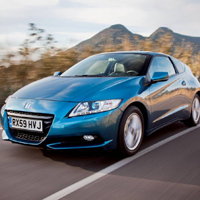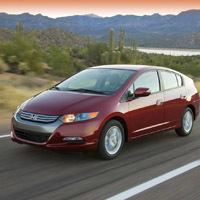
Australia’s love affair with SUV’s keeps on gathering momentum with records being broken almost monthly. The Honda CR-V is part of this increasing market segment.
The Honda CR-V was last significantly redesigned for 2007; at that time it grew slightly and was given a much more space-efficient interior. While some rivals cram three rows of seating into a vehicle this size, the 2010 CR-V sticks with two, and seating for five.
Depending on how you see it, the exterior of the 2010 Honda CR-V is understatedly attractive, plain, or a little weird. Inside, the CR-V strikes a better design balance and should appeal to nearly everyone. The upright instrument panel is a bit too upright and butch-SUV in styling, but it uses some pleasant contrasting materials and bright accents.
Despite the tall driving position, the CR-V drives pretty much like an economical, comfort-oriented sedan; handling feels stable but not very sporty. Honda has stuck with a single powertrain for the CR-V—a 2.4-liter four-cylinder, with a 6 speed manual or a five-speed automatic transmission. An improved all-wheel-drive system is available, and it works with the stability control system to send power to the wheels where it’s needed most.
The interior of the 2010 Honda CR-V is very spacious and can accommodate five adults rather comfortably (only four if you have broad-shouldered passengers in the backseat). The backseat itself is split into two sections and folds down to a completely flat cargo floor.
Safety features are a priority in a family-friendly vehicle like the CR-V, and it has all the features that are now expected, including electronic stability control, anti-lock braking, front side airbags, and side curtain airbags as standard making it quite possibly the safest vehicle in its class.
As in most Hondas, the top options are only offered on the most expensive, luxurious trims. If you can live with a somewhat basic features list, you’ll find the CR-V a bargain, but the top-of-the-line CR-V Luxury adds many of the most desirable features like dual-zone climate control, a power driver’s seat, and a premium audio system.
Also available are two new accessory packs which are available on all CR-V models, the Active pack and Modulo Sports pack. The ‘Active’ pack which includes Bluetooth, Side steps, Roof racks, Deluxe mats, Cargo protector tray, Chrome exhaust tip, side window visors, door sill garnish and dust and pollen filter. The ‘Modulo Sports’ features side steps, front skid plate, rear skid plate, Tailgate spoiler, Sports grille, Chrome exhaust tip and chrome mirror covers. Both packs sell for $2,699 including fitting.
What we also discovered when taking it for a spin on the open road was that the 2010 Honda CR-V gets more fun to drive the faster you drive it. Although that may seem contrary to the SUV norm, most of the thanks should be given to precise power steering. To top it all off, the 2010 Honda CR-V also manages to exhibit minimal body roll even during quick cornering maneuvers.
SUVs aren’t supposed to be fun to drive but apparently no one told the engineers at Honda. This, then, begs the question: Do CR-V owners who have never driven another SUV know that SUVs are supposed to be ponderous, soul sucking enemies of driving pleasure? Well, if they keep driving the Honda CR-V there really isn’t any point in telling them, now is there?
Honda CR-Z Achieves 5-Star Safety Rating

The Honda CR-Z, due in Australia mid 2011, has been rated one of Europe’s safest cars, achieving a maximum 5-stars in the latest independent crash testing results from Euro NCAP.
Euro NCAP’s rating scheme focuses on the vehicle’s overall safety performance which gives consumers an easy to understand single score. The system considers occupant protection in frontal, side, pole and rear impacts, child protection, pedestrian protection and the availability of driver aids.
The CR-Z is the latest in a series of Honda cars to receive top marks. The Honda Insight, which will be introduced later this year, was also named ‘safest hybrid vehicle’ as well as the 2nd safest vehicle tested in 2009.
Euro NCAP’s new assessment reflects Honda’s commitment to overall vehicle safety, complimenting Honda’s long standing in-house safety testing which seeks to improve real world safety. Honda’s car-to-car crash test facility at the Tochigi R&D centre analyses impacts between models of different sizes and weights and develops solutions to mitigate injuries for both passengers and pedestrians. The omni-directional vehicle-to-vehicle crash test facility opened in 2001 and is the world’s first indoor all-weather facility of its type.
Honda Insight 2010 World Green Car Awards Finalist
The second-generation Honda Insight is one of three finalists for the 2010 World Green Car award, to be announced at the New York International Auto Show on 1 April, 2010.
The winner of last year’s award was the Honda FCX Clarity.
The World Green Car awards began in 2004 to recognise and reward automotive excellence on an international scale. Judging criteria for the 2010 World Green Car award included: fuel consumption; exhaust emissions; and use of a major advanced power plant technology (beyond engine componentry) aimed specifically at increasing the vehicle’s environmental responsibility.
The second-generation Honda Insight represents over 20 years of hybrid development with its primary aim to make hybrid technology more affordable for more people.
Due to arrive in Australia late this year, the second-generation Honda Insight is the first in a new range of hybrid models to be launched by Honda in the near future.
Andrew Koch
***




